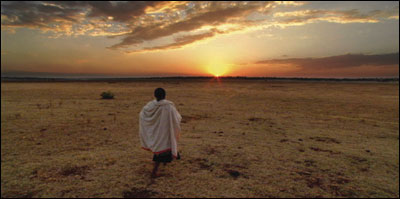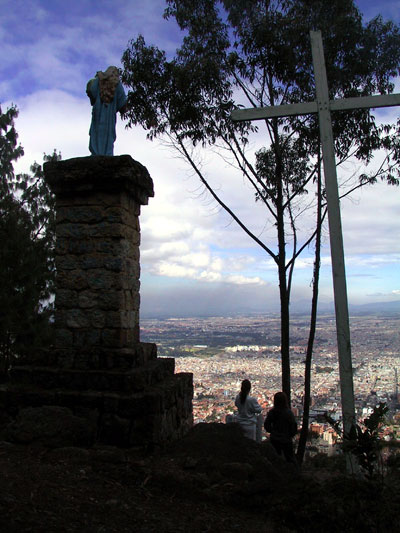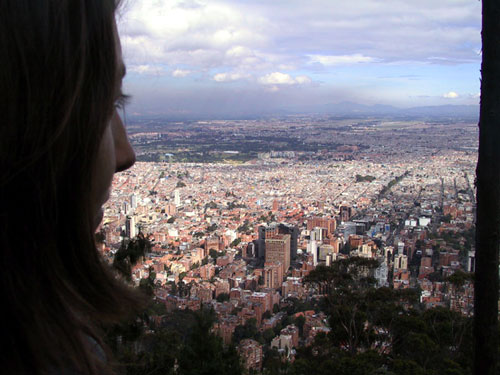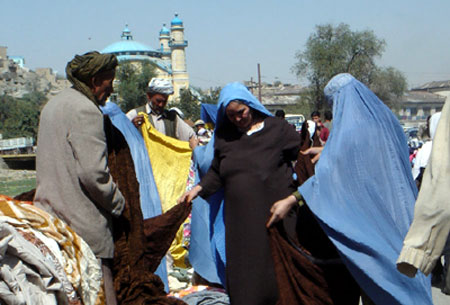
Two women inspect the merchandise in a Kabul street bazaar.
From the air, Afghanistan is a more rugged version of the moon. Approaching Kabul, our plane flies low over the surrounding mountains as we prepare to land. With the city center out of view, Kabul looks like the desiccated remnants of an ancient civilization. Only a few small patches of green glimmer in the haze — everything else is the color of dust.
It is my debut as a government agent. Two weeks before Afghanistan’s first-ever presidential elections, I am part of a State Department team helping shape global public opinion of the elections — and, by implication, improving America’s poor overseas reputation. It might be more appropriate to describe us as a few opportunistic freelance TV workers dabbling in propaganda. We have been hired by the U.S. government to produce video footage of the elections, footage that will be freely available to any television station that wants to use it. And although we will be operating independently, it is understood, of course, that we aren’t here to look for bad news.
Everyone knows Hamid Karzai, the American backed interim president, is going to win the election. The only questions are by how much, and whether or not Afghans — and the world —will believe the results. Our job is to make sure that, whatever the slant of the international media coverage, someone will be covering the good news in Afghanistan — if there is any. I wonder, though — as a hyper-liberal, anti-Bush zealot, do I really want to help put a good spin on United States foreign policy? On the other hand, we’re not exactly here to create a White House-sanctioned fantasy world a la Wag the Dog, either. So let’s call it “public relations” instead of propaganda. Or maybe “propaganda lite.”
Looking for trouble — and good camera angles
My friend Mathieu told me about the job a few months ago. He needed someone to come to Kabul with him and his colleague Siri, to be an audio tech during the day and a video editor at night. I had worked with them both before, and trusted them. Siri had been to Afghanistan several times in the last two years, and knew her way around the country.
I thought about it for a couple days. Things in Afghanistan looked less than promising. The U.N. Staff Union was lobbying to have U.N. employees pulled out of Afghanistan, and Doctors Without Borders, an non-governmental organization with a reputation for fearlessness, had pulled out altogether after 24 years in the country.
But how often do you get the chance to visit Afghanistan? I called Mathieu to tell him I would come. Second thoughts immediately followed when he asked for my hat and chest size to buy me a helmet and vest of body armor.
Once we land in Kabul, my doubts only grow.
At the airport we are met by Farid and Qais. Farid is our translator and guide, an earnest man in his early thirties. Qais is our driver, a snappy dresser with a mustache poised on his broad, slightly plump face. His minivan is bedecked with sunroofs, a metallic grey paint job, and the words “SUPER EXTRA” emblazoned on the sliding door. We pile in with our equipment, and Qais sends the Super Extra through Kabul’s chaotic traffic with a carefree recklessness bordering on glee.
I had imagined our security would be tight, envisioning fortified U.S. compounds as our lodging and fearsome convoys of armed humvees as escorts. In reality, the U.S.embassy hardly seems to know that we’re here, and our freewheeling Super Extra is apparently all the convoy we’re going to get. I tell myself incognito is better.
Qais and Farid drop us off at a modest Kabul guesthouse, run by an affable Australian chef. The outside is a drab wall with a metal door, but the inside is surprisingly pleasant. There is a central garden with a shady arbor where the other inhabitants — two dozen development workers and U.N. contractors — lounge in the evenings, drinking and playing ping-pong. After dumping our gear in our rooms, and setting up our editing computer, we sit on the patio and drink beers. There is a rumbling in the sky. We crane our heads. Two U.S. helicopters circle over the city, bristling with guns and rockets, rattling our windows.
Kabul is congested and dusty. Its recent history is evident in the sagging skeleton of a ravaged building or a wall pockmarked with the splash of a shell burst. But the etchings of violence are mainly just the backdrop for everyday bustle. Streams of men form a parade of flowing vests and tight cylindrical caps or flat pakol hats, which perch on the back of the head like a felt pancake. The flood of beige and brown is punctuated by an occasional Western suit, or by dark green camouflage jackets thrown over traditional clothing. Women in the streets wear conservative headscarves and long skirts with quietly defiant high heels and fishnet hose. There are also the almost genderless figures of women in flowing, sky-blue burqas, looking out through the embroidered face screen of a garment that, for an object so symbolic to us of sexual repression, is surprisingly beautiful.
Our job is to record life in Kabul and digest it into video clips for mass distribution, hopefully in a way that shows the current situation in a positive light. But these decisions aren’t up to me. I’m making absolutely no decisions about where we go and what we cover. My role is to tag along and get audio, leaving the thinking to Siri. She has been talking to the U.S. embassy in Kabul ever since we landed, and they aren’t offering her much guidance. Mostly, our movements are based on her gut feelings of what our employers will consider appropriate and — above all — what will make good television.
At the top of any cameraman’s list this week are the walls plastered with election materials. U.N. posters cheerily depict how an election is supposed to work. One shows a man and a woman, both smiling broadly, in traditional dress. A giant speech bubble hovers over them displaying the address of the nearest polling station.
There are also campaign advertisements from all 18 presidential hopefuls. Multiple posters for each candidate display the contender in varied poses of purposeful concentration. In vying for the passerby’s attention, however, a common image hovers in the background of many of the flyers: a man’s lined face, framed with a goatee, a shock of gray hair and a pakol hat. It is Massoud, the former head of the Northern Alliance, who was assassinated on September 9, 2001. His exploits are legendary: he defied more than hald a dozen Soviet assaults on his native Panjshir Valley, and later became the linchpin of anti-Taliban resistance. Now, with the fall of the Taliban, it seems Massoud is Afghanistan’s George Washington. And his sad-eyed ghost is everyone’s running mate.
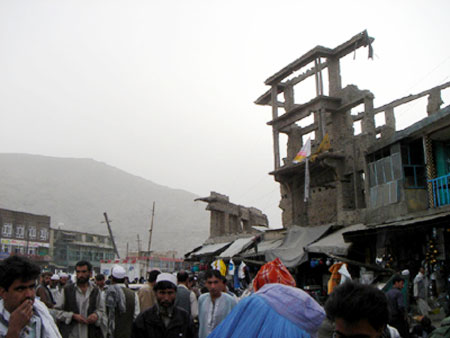
Above the hubbub of modern Kabul, gutted buildings linger as stark reminders of the civil war of the 1990s.
Democracy school
On the outskirts of Kabul, we visit a voter education class at a local high school. (Fresh-faced youth learning about democracy equals good video.) The classroom is packed with young men, few of whom look over 18, which is the Afghan voting age. The teacher explains that the boys are given the class in the hope that they will pass the information on to their families. We tape the teacher gesturing to a set of U.N. posters that illustrate parts of the election process — voter verification, the secret ballot, collection and counting of votes. The teenagers’ concentration is intense. Do American high school civics class ever look like this? Perhaps the presence of a news crew has a focusing effect, but their attention seems genuine.
Siri interviews the teacher. In broken English, he tells us it isn’t always easy to get across the idea of how an election works. “Of course, we think it’s difficult for them,” he says. “But we are explaining more.
He continues: “In the past government, has any president asked you, ‘Can I be your representative, your president?’ They say, ‘No.’ So it is the election, that they are asking, ‘Can you give your vote to me? Can I be your president?’ This is democracy!”
My skepticism weakens. It is one thing to sit home in front of the newspaper and make knowing comments about power politics. How legitimate is “democracy” when it is imposed by an invading superpower, and when a country’s human development and rule of law remain in ruins? Those sentiments fade, however, when confronted with the straight-faced optimism of a classroom like this. Clearly, this is what we were paid to find, with the idea that our footage will have the same effect on viewers.
One dawn, Mathieu, Farid and I decide to hike up to the old city wall for a panoramic view. Mathieu has the constant, almost visceral craving for high, unobstructed wide shots that is common among good cameramen. To get to the crumbling ruin, we walk through a shantytown of mud brick houses. Several boys run out to accompany us. We climb on top of the wall, which runs precipitously down the side of the mountainous ridge that divides the city into two lobes. The boys tell us we shouldn’t go any farther, as there is a guard who haunts the other side of the hill, and he will be tempted to shoot at us if we continue. We are happy to stay put on the wall. From here, we can see Kabul stretching into the distance, a high flat plain ringed by bare mountains. Clouds of smog and dust rise towards the harsh morning sun.
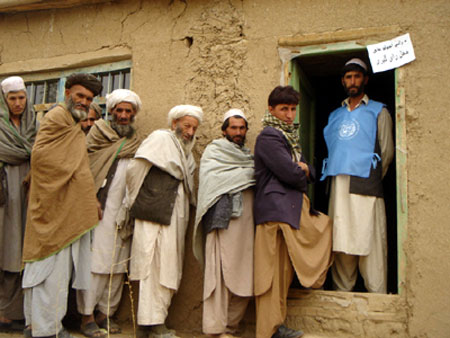
In the town of Nasri, voters wait outside a mosque. An election worker checks registration cards at the door.
Fallout
Siri decides we should go to Bamiyan, the site of a pair of giant Buddha statues that were destroyed by the Taliban in 2001. There is a Provincial Reconstruction Team (PRT) there, a small military base run by the New Zealand army. It is an irresistible opportunity to make a favorable contrast between the multinational forces and the Taliban.
Bamiyan is perhaps a hundred miles away, but it takes us twelve hours by van to negotiate the bumps and potholes of Afghanistan’s country roads. Between Kabul and Bamiyan, the landscape morphs. We rise through high, mountainous desert, almost totally devoid of vegetation, with giant toothy peaks looming in the distance. We pass drought-stricken villages with plowed fields of dust. Other villages are labyrinths of mud brick walls razed halfway to the ground. We spot an occasional Soviet tank lying destroyed beside the road, a vestige of the 1980s. Sometimes their cannon barrels are burnished and shining from years of being climbed by local children, or their sides are stenciled with advertisements (“Afghan tourism organization — Bamiyan Hotel”). Tank treads turn up as speed bumps on village roads. Spent shells appear as eaves holding up roofs, or as the edges of packed-earth porches.
We drive past healthier-looking villages of square adobe houses, puzzle-like assemblies of clay cubes nestled at the bottom of ridges. Children steer herds of goat and sheep, waving as we drive by. It is impossible to tell how old the houses are. Everything is made of baked, dust-covered earth. A ruined village: Was it left many decades ago to fall into disrepair? Or was it reduced to rubble in the civil war of the 1990s?
Thick clouds of powdery dust rise around us everywhere as we drive, entering the less-than-hermetically-sealed Super Extra. Soon all of us and our gear are the same color as the landscape. We wrap bandanas around our faces and Mathieu wraps a scarf around his video camera, the source of his livelihood, and clutches it to himself. “It’s alright, baby,” he croons. “It’ll be over soon.”
We reach the hotel in Bamiyan after dark, and in the morning we awake to the most inviting place we have seen in Afghanistan so far. The valley is a lively patchwork of green and earthy fields flanked by soaring rocky cliffs. The cliffs bear scores of little alcoves, carved by Buddhist monks fifteen hundred years ago. This rocky honeycomb houses three giant alcoves, the larger two of which once hosted Bamiyan’s famed Buddhas.
The Taliban achieved a special level of notoriety when they destroyed Bamiyan’s two giant Buddhas in early 2001. Perhaps more serious than the destruction of those ancient statues, though, were the attacks on the local people. In the ethnically Hazara region around Bamiyan, the rule of the Taliban, who are ethnic Pashtuns, was especially harsh. To tighten control over the region, they massacred locals and destroyed their communities.
Looming over one end of the valley are the ancient ruins of the hill fortress Gholghola — a labyrinthine citadel that eerily suggests Bosch’s image of the tower of Babel. In the 13th century, Genghis Khan laid siege to this fortress city as he took control of the valley. The death in combat of one of his grandsons made him even more brutal than usual, and when the city fell he slaughtered all its residents and laid waste to the surrounding valley. Only in Afghanistan, perhaps, do such tales not seem dusty and ancient. They live on in their modern versions: Russian gunships obliterating entire villages, Taliban massacres, giant statues falling from their ancient places in the cliffs — and, although I can’t tell which craters are which, U.S. bombs also figure in the litany of destruction. Genghis Khan’s wrath was just a signpost on a bleak road that still stretches on.
Now that both Khan and the Taliban are gone, however, life is returning to Bamiyan. Farid, who knows the town from earlier times, notices renewed life and activity. The central bazaar, a dirt road lined with two rows of trees, has doubled in size over the last year. It is now the bustling center of town, with a quorum of enthusiastic rug and trinket sellers that recalls the days, several decades past, when Afghanistan hosted more tourists than journalists. The story is perhaps not so rosy in other parts of the country, though, where the collapse of the Taliban’s strong central rule may have been politically liberating, but has also created an atmosphere of lawlessness that does little to help the common people. But lawlessness is not our beat, which is why we are in a place like Bamiyan.
Dragon slaying
Even in Bamiyan, times of relative peace have a military undercurrent. On a hill just opposite Gholghola is a New Zealand military base. We spend some time following a patrol, the Super Extra falling in line with the convoy. After recording a good amount of friendly-soldiers-interact-with-peaceful-locals footage, the Kiwis take us to the Valley of the Dragon for some heavily armed sightseeing.
According to local legend, the valley is named for a dragon that used to terrorize the villagers. A prince, with a single blow of his sword, hewed the beast into two rocky halves separated by a narrow fissure. The valley is a wide, forbidding gorge of Martian rock and dust. At the end, the ground rises steeply to close off the basin with a high, rocky ridge — the dragon’s carcass. To climb the precipice, we abandon our overheating Super Extra for military pickups, bumping and jolting as we ascend the dragon’s side. At the top, the soldiers kindly set up a perimeter to guard our sightseeing. On our right lies the gigantic, empty expanse of the valley. On the left, the ridge descends gradually to a bleak stretch of desert peppered with two shepherds and a dozen motley sheep.
On the road back to Kabul, we come across a village road crowded with people eagerly awaiting a campaign visit from Mohaqiq, one of the major presidential candidates. In a few minutes, as if on cue, the crowd starts to clap. At the bottom of the hill appears a green sport-utility vehicle with the candidate standing in the sunroof. The SUV creeps forward, a handful of machine-gun bearing guards surrounding it. The crowd mobs the truck. A man in sunglasses is screaming slogans into a microphone. Mathieu and I fight our way back and forth to get different shots.
Mohaqiq eventually dismounts from his SUV and makes his way over the side of the road towards a field where his fans will convene. When we reach the edge of the road, I see the rocks are spattered with blood. A sacrificed sheep, still kicking, lies at an old man’s feet, opened at the throat, glistening red in the sun. The man, wizened and toothy, salutes the camera, smiling as he raises his palms skyward, the knife dripping, his hands covered with blood.
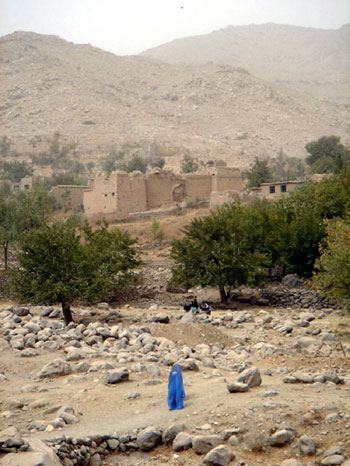
After voting, two burqa-clad women return to their village.
Day of anticipation
Back in Kabul, Election Day dawns with a strange, yellow sky. There has been a dust storm during the night, and the sun is invisible behind an ochre haze. Wisps of sand swirl across the city’s eerily deserted streets. Finally the moment is here, when all hell is supposed to break lose, vindicating the months of media hype.
We drive north to visit polling places in the countryside. Next to a low-slung adobe mosque in the village of Nasri, crowds of men mill around and talk. There are no women — voting is segregated, and Nasri’s women are casting their ballots at a polling station up the road. Two Afghan policemen sit on chairs in a field to the side, AK-47s resting across their laps. Snaking into the green-framed doorway is a line of men. At the entrance, a local man with a blue polyester U.N. vest checks registration cards and thumbs. Each voter gets his registration card punched and his thumb painted with indelible ink, which ensures that only one vote will be cast per person. We later learn this system has been bungled in some parts of the country, leading to charges of fraud.
The hush inside the mosque brings a sacred air to an otherwise secular ritual. Yellow plastic tape divides the room into two voting sections. After checking in at one table (and getting his thumb painted), each man goes to another table to get his ballot — a long, green sheet of paper. The photograph of each of the 18 candidates appears next to each name, accommodating the 70-odd percent of Afghans who are illiterate.
The men working the polling station have put on the slightly huffy air of the petty bureaucrat, but otherwise are indistinguishable from the townspeople casting their votes. At the ballot table, one man in a white Afghan cap dutifully folds each ballot and marks it with an official stamp before handing it to the voter, explaining with an upraised finger that they must remember to fold it up again before emerging from the curtained voting booth. After ducking under the curtain for a short while, each man emerges and tucks his ballot into a large plastic bin, which is guarded by another election worker. Through the clear plastic, we can see it slowly filling up with ballots.
Up the road, Siri is allowed into a women’s polling station with a small camcorder. The women all arrive draped in burqas, but inside the polling station, they throw them back like shawls as they shuttle from the check-in table to the booths to the ballot box. The polling station supervisor, a woman called Najiba, interprets for Siri as she asks a pair of women what they think of their first election. “I’m happy to vote,” says one. “I hope for a peaceful country where our children can get an education.” The woman next to her adds, “We want peace and stability and a free country.”
“They are very happy,” adds Najiba in halting English, beaming. “They say, ‘We were waiting for such a day, that we can come and put [our votes] in the box.’ They look happy.”
They do look happy, and they are making our job surprisingly easy. At the other voting sites we visit — indeed, at polling stations all across the country, we later learn — the scene is peaceful, almost beatific. We ask several men for their impressions, and they reel off answers that George Bush should have monogrammed on his suit lapels:
“Elections means selecting someone who will help the country and the poor. I have made my choice from the ballot, and I hope my candidate will win.”
“It was completely confidential. Nobody checked my ballot. I voted they way I wanted to, and I’m very pleased.”
“We’re happy to have these elections after 23 years of war. We cast our ballots without being told whom to vote for, and everyone has voted according to his own choice.”
I feel like I’ve been cornered into PR heaven. Where is the bitterness? Where is the distrust? The worst we have found is a certain resignation, born from experience, that the United States and its allies may leave and allow another civil war. But under the circumstances, such a wait-and-see attitude seems remarkably hopeful, if not idealistic.
When we return to the guesthouse, we will watch BBC and CNN on satellite TV. The international media will focus initially on failures of the Afghan election system — ink that rubs off thumbs, voters with multiple registrations — before noting the miraculous: no polling places have been attacked, and turnout has been heavy, especially considering the climate of fear during the campaign.
The election seems to have been a great leap of faith on the part of the Afghans. But does it represent a turning point for their country? I wonder how much relevance a peaceful election has for a country beset by warlords and overwhelmed with poverty and illiteracy. I suppose it is naive to be optimistic.
Cruising back to Kabul, I watch from the windows of the Super Extra. As a landscape of destroyed buildings slides by, painted with the white checkmarks and red stripes of the de-mining crews, I quietly hope Afghanistan’s good news will continue.
Andrew Blackwell
Dear Reader,
In The Fray is a nonprofit staffed by volunteers. If you liked this piece, could you
please donate $10? If you want to help, you can also:
 You may or may not think that the stimulus checks the government is sending out this month make good economic sense, but either way, you’ve got to decide what to do with the extra 300 to 600 bucks. You could buy yourself a bottle of 1980 Dom Perignon, for instance, or take yourself and 29 friends to see Speed Racer. But in case you want to put some of your windfall to work for a good cause, here are 10 specific, action-ready ideas:
You may or may not think that the stimulus checks the government is sending out this month make good economic sense, but either way, you’ve got to decide what to do with the extra 300 to 600 bucks. You could buy yourself a bottle of 1980 Dom Perignon, for instance, or take yourself and 29 friends to see Speed Racer. But in case you want to put some of your windfall to work for a good cause, here are 10 specific, action-ready ideas:

